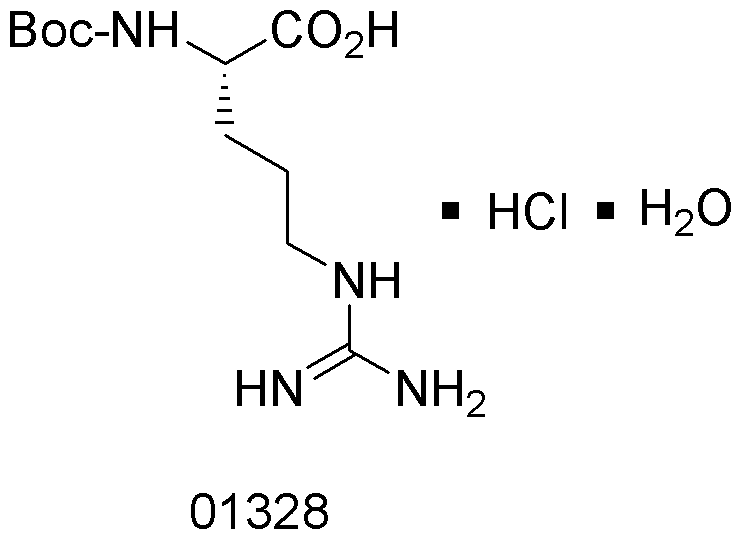Na-Boc-L-arginine hydrochloride hydrate is widely utilized in research focused on:
- Peptide Synthesis: This compound serves as a key building block in the synthesis of peptides, particularly in the pharmaceutical industry, where it helps in developing therapeutic agents.
- Bioconjugation: It is used in bioconjugation processes to attach biomolecules to surfaces or other molecules, enhancing drug delivery systems and diagnostic tools.
- Research in Cardiovascular Health: Researchers utilize this compound to study nitric oxide production, which is crucial for cardiovascular health, potentially leading to new treatments for heart diseases.
- Gene Delivery Systems: The compound is explored in gene therapy applications, where it aids in the effective delivery of genetic material into cells, improving the efficacy of gene therapies.
- Protein Modification: It is employed in the modification of proteins to enhance their stability and functionality, which is vital in biopharmaceutical development.
Información general
Propiedades
Seguridad y normativas
Aplicaciones
Na-Boc-L-arginine hydrochloride hydrate is widely utilized in research focused on:
- Peptide Synthesis: This compound serves as a key building block in the synthesis of peptides, particularly in the pharmaceutical industry, where it helps in developing therapeutic agents.
- Bioconjugation: It is used in bioconjugation processes to attach biomolecules to surfaces or other molecules, enhancing drug delivery systems and diagnostic tools.
- Research in Cardiovascular Health: Researchers utilize this compound to study nitric oxide production, which is crucial for cardiovascular health, potentially leading to new treatments for heart diseases.
- Gene Delivery Systems: The compound is explored in gene therapy applications, where it aids in the effective delivery of genetic material into cells, improving the efficacy of gene therapies.
- Protein Modification: It is employed in the modification of proteins to enhance their stability and functionality, which is vital in biopharmaceutical development.
Documentos
Hojas de datos de seguridad (HDS)
La SDS proporciona información de seguridad completa sobre la manipulación, el almacenamiento y la eliminación del producto.
Especificación del producto (PS)
La PS proporciona un desglose completo de las propiedades del producto, incluida la composición química, el estado físico, la pureza y los requisitos de almacenamiento. También detalla los rangos de calidad aceptables y las aplicaciones previstas del producto.
Certificados de análisis (COA)
Busque certificados de análisis (COA) ingresando el número de lote del producto. Los números de lote y de partida se pueden encontrar en la etiqueta de un producto después de las palabras "Lote" o "Lote".
Número de catálogo
Número de lote/lote
Certificados de origen (COO)
Este certificado de origen confirma el país en el que se fabricó el producto y también detalla los materiales y componentes utilizados en él y si se deriva de fuentes naturales, sintéticas u otras fuentes específicas. Este certificado puede ser necesario para cumplir con las normativas aduaneras, comerciales y regulatorias.
Número de catálogo
Número de lote/lote
Hojas de datos de seguridad (HDS)
La SDS proporciona información de seguridad completa sobre la manipulación, el almacenamiento y la eliminación del producto.
DownloadEspecificación del producto (PS)
La PS proporciona un desglose completo de las propiedades del producto, incluida la composición química, el estado físico, la pureza y los requisitos de almacenamiento. También detalla los rangos de calidad aceptables y las aplicaciones previstas del producto.
DownloadCertificados de análisis (COA)
Busque certificados de análisis (COA) ingresando el número de lote del producto. Los números de lote y de partida se pueden encontrar en la etiqueta de un producto después de las palabras "Lote" o "Lote".
Número de catálogo
Número de lote/lote
Certificados de origen (COO)
Este certificado de origen confirma el país en el que se fabricó el producto y también detalla los materiales y componentes utilizados en él y si se deriva de fuentes naturales, sintéticas u otras fuentes específicas. Este certificado puede ser necesario para cumplir con las normativas aduaneras, comerciales y regulatorias.


